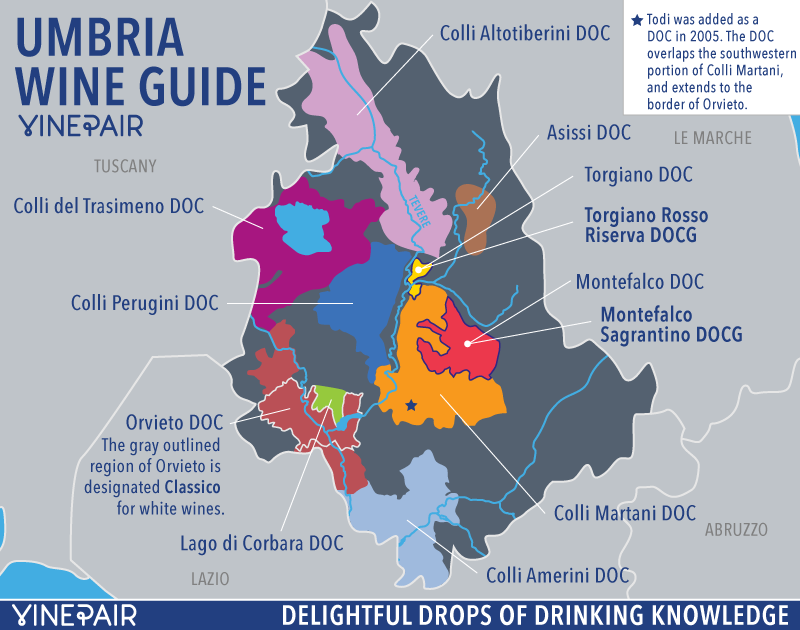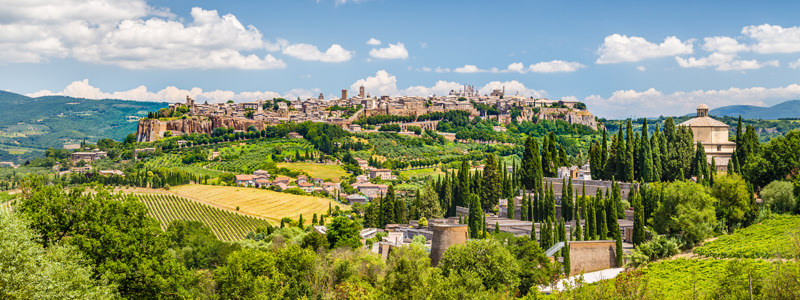Come with me to the center of Italy. To a place that once stretched from the eastern Tiber river all the way up to the Po Valley, but today is the fourth smallest region of the Apennine peninsula. A place named after the Greek word Ombrikoi, which means rainy, that is decorated with ancient villages and bucolic hill towns. Umbria, the only region of Italy without a coastline or an international border. It is enveloped by the borders of Tuscany to the north, Le Marche to the east and Lazio, the center of the ancient Roman Empire, to the west. Its climate is the same as Tuscany, with rainy winters and sunny dry summers, yet the region is overshadowed by its northern neighbor, only producing one third the amount of wine that Toscana dishes out. And that is good news! While the tourists are winding their way through the urban sprawl of Florence, waiting in lines at packed Tuscan wineries and enjoying bus tours in Rome, you can ramble in peace through Umbria’s humble hills and find some very stunning wine.
Umbria has around a dozen wine zones (DOC, DOCG & IGT) and while great wine can be found in all of them, there are a select few that really make large enough amounts to be available on the American market. Out of these zones, the Orvieto DOC, Montefalco DOC and Montefalco Sagrantino DOCG are the most well known. These are the regions that are the most popular to visit and the ones from where you’ll have the best luck at finding wine when you’re back home.
Orvieto DOC
In and around the medieval town of Orvieto in the province of Terni lies Umbria’s largest production zone, awarded its DOC status in 1972, and producing 80% of the entire region’s wine. Wines from this area have been celebrated since the Middle Ages, but originally the wine that was celebrated was a sweet wine which, though it still exists here and is wonderful with the local cheeses and cured wild boar, is not currently the main attraction. Today what Orvieto is known for is its dry white wine. Although these wines can be refreshing on their own, where they truly shine is when paired with food. The whites of Orvieto are blends comprised of local grapes such as the deep and weighty Grechetto and the light and minerally Trebbiano (known as Procanico here) along with other native varieties such as Drupeggio (Canaiolo Bianco) and Malvasia. The result is a soft, deep white wine with notes of almonds and chamomile which is brightened up with hints of crisp golden apple. The weightier whites have more Grechetto in their blends and are often found in the Classico sub zone. Although these wines may cost a bit more because of smaller production, they are delicious. Pair Orvieto’s white wines with meat and cheese plates or the Umbrian classic porchetta. There is a very wide range of pricing for these bottles from $9 up to around $40.
Montefalco Sagrantino DOCG
Umbria is full of breathtaking hilltop towns and Montefalco is one of them. Situated in the province of Perugia, this is the home of the Sagrantino grape. Wines made from this grape are full of power and depth with a significant tannin structure. Sagrantino actually has some of the highest tannin levels of any grape in the world, which allows it to age for a very long time. Montefalco Sagrantino’s DOCG was awarded in the 1990s when Italy was in the throes of a Super Tuscan craze and the wines from this area were celebrated not only for their quality but for the fact that they cost less than the big guns to the north. Fire up the grill! Go get some wild boar! This wine is for big dishes. Inky purple in color and dark to its core, this wine goes right to the soul and stays there with notes of plum, cinnamon and earth mingling with dark cherry. As it ages it sometimes even develops a slight smoky note as well. Despite the long aging requirements – 37 months – the prices of these wines are still quite affordable ranging from $15 to around $30 plus.
Montefalco Rosso DOC
Wrapped up in the the Sagrantino DOCG is this sub zone. It allows winemakers to release wine to the market while the Sagrantino is aging. This wine also gives focus to Umbria’s other important grape, Sangiovese. Where Sagrantino is deep and powerful, Montefalco Rosso tends to be softer. The blend is mostly Sangiovese (60%-70%) with up to 15% of big ol’ Sagrantino. The DOC also allows Cabernet Sauvignon and Merlot in the blend, all the way up to 30%. As you can see, this grants winemakers quite a bit of room for individuality. Generally these wines aren’t meant for long aging and are calmer and more vibrant in youth than Sagrantino. The Sangiovese does its job brightening up the party with vibrant cherry fruit while the Sagrantino brings the muscle, holding up the structure of the wine. When Merlot – often used in larger quantities than Cab – is blended in it adds a soft suppleness to the mix, making the wine one of the most versatile food-friendly reds from the boot. And these wines are very affordable! Most Montefalco Rosso can be found for around $15 to $20.
I will leave you here as the sun sets over the hill town of Spoleto while you take in the sounds of the annual Jazz Festival and gaze upon the quiet countryside with the occasional zoom-zoom of a Vespa careening through the ancient alley ways. Or maybe you’ll be sitting atop Monte Subasio in Assisi as you sip on the local Montefalco blend fireside at one of the region’s best kept restaurant secrets (until now), Fontemaggio, where the regional menu and many carafes of wine will make you pinch yourself to make sure it’s not a dream.


